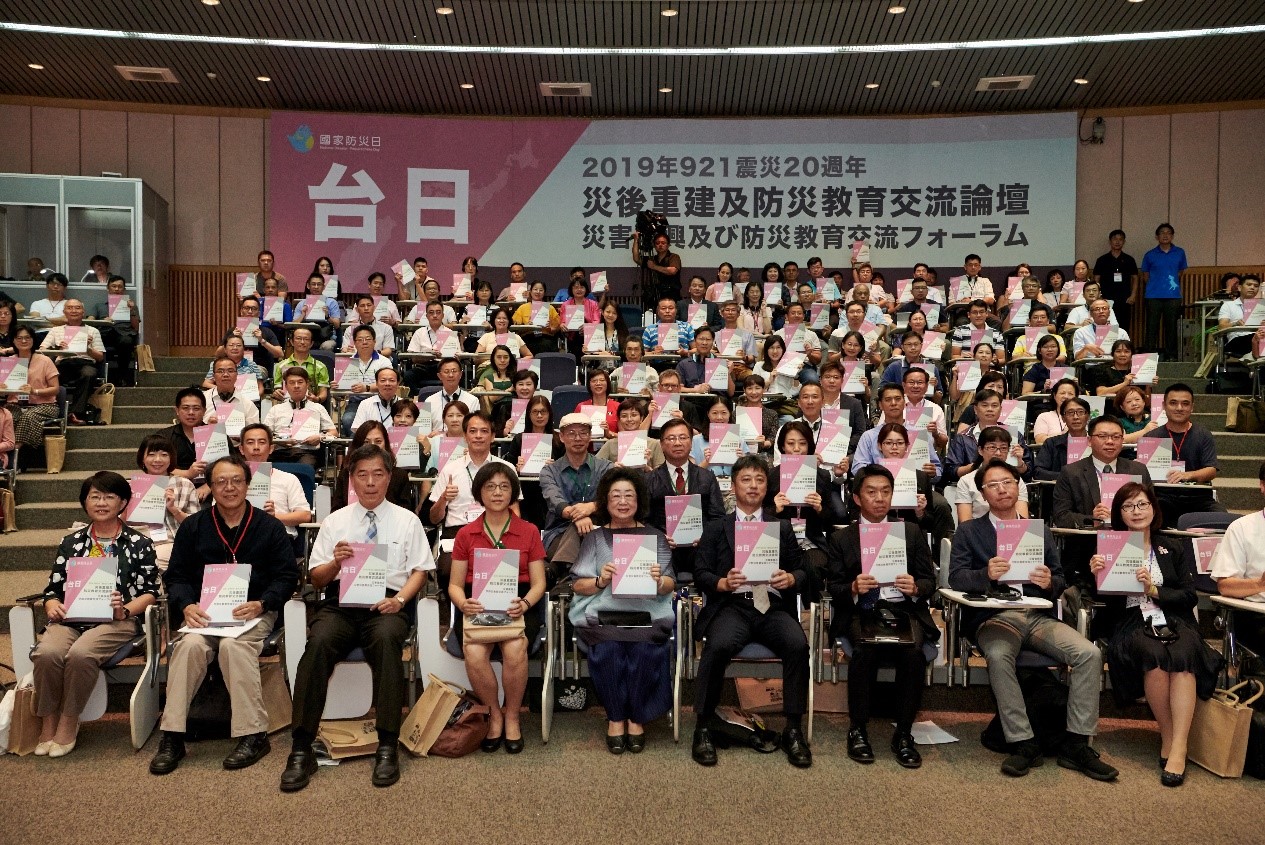Taiwan-Japan Disaster Prevention Experience Interchange - Sharing Together Resilience Disaster Risk Reduction Education 20th Anniversary of the 921 Earthquake - Retrospection and Prospection of Taiwan-Japan Recovery Status of Disaster

On September 19, 2019, the Ministry of Education and Japan-Taiwan Exchange Association jointly invited experts and scholars of disaster risk reduction (DRR) education from Taiwan and Japan to participate in the forum of the 20th Anniversary of the 921 Earthquake - Retrospection and Prospection of Taiwan-Japan Recovery Status of Disaster in the National Museum of Natural Science, where more than 200 education staff and representatives from related authorities and private organizations attended. The Commissioner, Futoshi Muraoka, from Miyigi, Japan, was especially invited to the forum to share the DRR education in Miyigi and the current recovery status of the Great East Japan Earthquake. After the impact of the Great East Japan Earthquake on March 11, 2011, the Miyigi County Government has devoted itself into developing DRR education. The shared contents included the following measures, which have been noticed for making the DRR education in Miyigi County the most advanced among all Japanese counties:
- Schools are the DRR core in communities, to enable teachers, students and the public in communities to get together and to comprehend the requirements of DRR and emergency evacuation in communities.
- The establishment of DRR education promotion purposes.
- The implementation of DRR projects in schools and communities.
- The enhancement of DRR education in schools supervised by an education committee within regions and counties.
- The implementation of youth DRR team member training activities to enable them to be capable of helping themselves and others.
- The combination of DRR research resources in universities to develop both DRR teaching materials and to develop measures appropriate to all school ages.
The project lecturer, Mari Yasuda, from the International Research Institute of Disaster Science (IRIDeS) was also invited to the forum, who expressed that through DRR education and the utilization of new forms of technology, feasible technology DRR education can be established, so as to strengthen teachers’ and students’ awareness of DRR.
On the night of September 19, representatives of Miyigi and related DRR specialists visited the Taomi-Ecovillage, which was arranged by the Ministry of Education and the NewHomeland Foundation. Since the early Qing dynasty, ancestors had started reclamation in the Taomi-Ecovillage, where placid rivulets meander smoothly through green woods and everywhere is surrounded by pleasant trees, abundant ecological diversity has been nurtured. Although severely damaged by the 921 Earthquake, the pretty village recalled and assembled the collective power of the community, which found out the revival opportunity, setting about environmental education, and this consequently became its opportunity of formatting the ecovillage.
A Paper Dome and the 921 Earthquake Museum are located in the Ecovillage. Memories of the earthquake continuously educate all the visitors through installation art, illustration of images, and photo records. Among all facilities, the renowned Paper Dome is not only an important symbol of the connection between Taiwan and Kobe-shi, but also an interchange platform of community building and rebuilding of those damaged by the earthquake in both places. Guests from Japan and Taiwan prayed with both hands closed and took pictures in front of the Blessing Frog statue which was set up after the Great East Japan Earthquake. This arrangement of the agenda was greatly recognized and appreciated by the Japanese guests.
In addition, to enable representatives of Miyigi and related DRR specialists have a greater impression of the 921 earthquake status at that time, a visit to the 921 Earthquake Museum was organized (in Kuang-Fu Junior High School in Wufeng District). In the museum, the geomorphy such as fault displacement, collapsed school houses, and riverbed upheaval presented a narrative space structure in the order of a timeline, and an epitome of the 921 Earthquake, which raises people’s attention to DRR, guides them to realize its importance, and demonstrates the determination of our nation in promoting DRR education via historical disasters. After the visit, representatives of Miyigi and Japanese DRR specialists expressed their shock brought by our preservation of historical disaster fields and faults presented in the museum, and said they would bring experiences of historical disaster field preservation and DRR education back to Japan, hoping that more Japanese could come to the museum to witness environmental changes caused by earthquakes.
Correspondingly, we can also absorb experience from DRR education promotion cases of Miyigi county in Japan. The Ministry of Education will promote the DRR education pattern that schools are cores of autonomous DRR in communities based on future circumstances of catastrophes, and will devote itself to applying and integrating novel technology into DRR education to enable teachers, students and people to experience the realistic novel technology. A novel early warning function of DRR technology can efficiently raise all people’s awareness, knowledge and skills of DRR, and turn the attitude of DRR into one part of our daily life.
